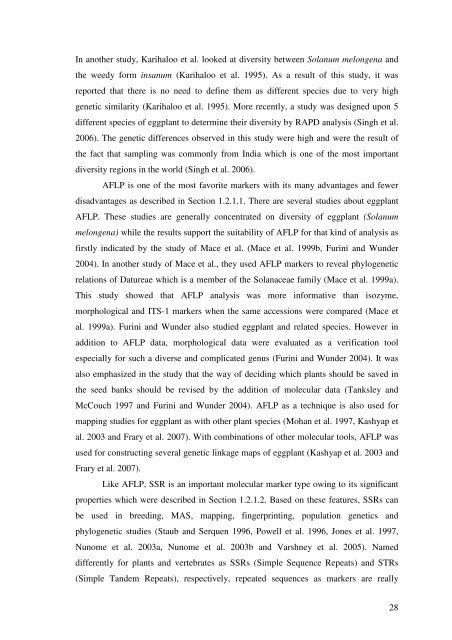determination of genetic diversity between eggplant and its wild ...
determination of genetic diversity between eggplant and its wild ...
determination of genetic diversity between eggplant and its wild ...
Create successful ePaper yourself
Turn your PDF publications into a flip-book with our unique Google optimized e-Paper software.
In another study, Karihaloo et al. looked at <strong>diversity</strong> <strong>between</strong> Solanum melongena <strong>and</strong><br />
the weedy form insanum (Karihaloo et al. 1995). As a result <strong>of</strong> this study, it was<br />
reported that there is no need to define them as different species due to very high<br />
<strong>genetic</strong> similarity (Karihaloo et al. 1995). More recently, a study was designed upon 5<br />
different species <strong>of</strong> <strong>eggplant</strong> to determine their <strong>diversity</strong> by RAPD analysis (Singh et al.<br />
2006). The <strong>genetic</strong> differences observed in this study were high <strong>and</strong> were the result <strong>of</strong><br />
the fact that sampling was commonly from India which is one <strong>of</strong> the most important<br />
<strong>diversity</strong> regions in the world (Singh et al. 2006).<br />
AFLP is one <strong>of</strong> the most favorite markers with <strong>its</strong> many advantages <strong>and</strong> fewer<br />
disadvantages as described in Section 1.2.1.1. There are several studies about <strong>eggplant</strong><br />
AFLP. These studies are generally concentrated on <strong>diversity</strong> <strong>of</strong> <strong>eggplant</strong> (Solanum<br />
melongena) while the results support the suitability <strong>of</strong> AFLP for that kind <strong>of</strong> analysis as<br />
firstly indicated by the study <strong>of</strong> Mace et al. (Mace et al. 1999b, Furini <strong>and</strong> Wunder<br />
2004). In another study <strong>of</strong> Mace et al., they used AFLP markers to reveal phylo<strong>genetic</strong><br />
relations <strong>of</strong> Datureae which is a member <strong>of</strong> the Solanaceae family (Mace et al. 1999a).<br />
This study showed that AFLP analysis was more informative than isozyme,<br />
morphological <strong>and</strong> ITS-1 markers when the same accessions were compared (Mace et<br />
al. 1999a). Furini <strong>and</strong> Wunder also studied <strong>eggplant</strong> <strong>and</strong> related species. However in<br />
addition to AFLP data, morphological data were evaluated as a verification tool<br />
especially for such a diverse <strong>and</strong> complicated genus (Furini <strong>and</strong> Wunder 2004). It was<br />
also emphasized in the study that the way <strong>of</strong> deciding which plants should be saved in<br />
the seed banks should be revised by the addition <strong>of</strong> molecular data (Tanksley <strong>and</strong><br />
McCouch 1997 <strong>and</strong> Furini <strong>and</strong> Wunder 2004). AFLP as a technique is also used for<br />
mapping studies for <strong>eggplant</strong> as with other plant species (Mohan et al. 1997, Kashyap et<br />
al. 2003 <strong>and</strong> Frary et al. 2007). With combinations <strong>of</strong> other molecular tools, AFLP was<br />
used for constructing several <strong>genetic</strong> linkage maps <strong>of</strong> <strong>eggplant</strong> (Kashyap et al. 2003 <strong>and</strong><br />
Frary et al. 2007).<br />
Like AFLP, SSR is an important molecular marker type owing to <strong>its</strong> significant<br />
properties which were described in Section 1.2.1.2. Based on these features, SSRs can<br />
be used in breeding, MAS, mapping, fingerprinting, population <strong>genetic</strong>s <strong>and</strong><br />
phylo<strong>genetic</strong> studies (Staub <strong>and</strong> Serquen 1996, Powell et al. 1996, Jones et al. 1997,<br />
Nunome et al. 2003a, Nunome et al. 2003b <strong>and</strong> Varshney et al. 2005). Named<br />
differently for plants <strong>and</strong> vertebrates as SSRs (Simple Sequence Repeats) <strong>and</strong> STRs<br />
(Simple T<strong>and</strong>em Repeats), respectively, repeated sequences as markers are really<br />
28

















